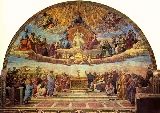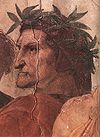
Disputation of the Holy Sacrament
Encyclopedia
The Disputation of the Sacrament , or Disputa, is a painting
by the Italian
Renaissance
artist Raphael
. It was painted between 1509 and 1510 as only the first part of Raphael's commission to decorate with fresco
es the rooms that are now known as the Stanze di Raffaello
, in the Apostolic Palace
in the Vatican
. At the time, this room was known as the Stanza della Segnatura, and was the private papal library where the supreme papal tribunal met.
 In the painting, Raphael has created a scene spanning both heaven and earth. Above, Christ
In the painting, Raphael has created a scene spanning both heaven and earth. Above, Christ
is surrounded by the Blessed Virgin Mary, John the Baptist
and various biblical figures such as Adam, Moses
and Jacob
. God the Father sits above Jesus, depicted reigning over the golden light of heaven. Below, on the altar sits the monstrance
.
The altar
is flanked by theologians who are depicted debating Transubstantiation
. Christ's body is represented in the eucharist
, which is discussed by representatives of the Church; among them are Pope Julius II
, Pope Sixtus IV
, Savonarola and Dante Alighieri
. Pope Sixtus IV is the gold dressed pope in the bottom of the painting. Directly behind Sixtus is Dante, wearing red and sporting a laurel wreath (symbolizing his greatness as a writer). In the left hand corner, there is a bald figure reading a book leaning over a railing. This is Raphael's mentor and Renaissance architect Bramante.
Painting
Painting is the practice of applying paint, pigment, color or other medium to a surface . The application of the medium is commonly applied to the base with a brush but other objects can be used. In art, the term painting describes both the act and the result of the action. However, painting is...
by the Italian
Italy
Italy , officially the Italian Republic languages]] under the European Charter for Regional or Minority Languages. In each of these, Italy's official name is as follows:;;;;;;;;), is a unitary parliamentary republic in South-Central Europe. To the north it borders France, Switzerland, Austria and...
Renaissance
Renaissance
The Renaissance was a cultural movement that spanned roughly the 14th to the 17th century, beginning in Italy in the Late Middle Ages and later spreading to the rest of Europe. The term is also used more loosely to refer to the historical era, but since the changes of the Renaissance were not...
artist Raphael
Raphael
Raffaello Sanzio da Urbino , better known simply as Raphael, was an Italian painter and architect of the High Renaissance. His work is admired for its clarity of form and ease of composition and for its visual achievement of the Neoplatonic ideal of human grandeur...
. It was painted between 1509 and 1510 as only the first part of Raphael's commission to decorate with fresco
Fresco
Fresco is any of several related mural painting types, executed on plaster on walls or ceilings. The word fresco comes from the Greek word affresca which derives from the Latin word for "fresh". Frescoes first developed in the ancient world and continued to be popular through the Renaissance...
es the rooms that are now known as the Stanze di Raffaello
Raphael Rooms
The four Stanze di Raffaello in the Palace of the Vatican form a suite of reception rooms, the public part of the papal apartments. They are famous for their frescoes, painted by Raphael and his workshop...
, in the Apostolic Palace
Apostolic Palace
The Apostolic Palace is the official residence of the Pope, which is located in Vatican City. It is also known as the Sacred Palace, the Papal Palace and the Palace of the Vatican...
in the Vatican
Vatican City
Vatican City , or Vatican City State, in Italian officially Stato della Città del Vaticano , which translates literally as State of the City of the Vatican, is a landlocked sovereign city-state whose territory consists of a walled enclave within the city of Rome, Italy. It has an area of...
. At the time, this room was known as the Stanza della Segnatura, and was the private papal library where the supreme papal tribunal met.
Description

Christ
Christ is the English term for the Greek meaning "the anointed one". It is a translation of the Hebrew , usually transliterated into English as Messiah or Mashiach...
is surrounded by the Blessed Virgin Mary, John the Baptist
John the Baptist
John the Baptist was an itinerant preacher and a major religious figure mentioned in the Canonical gospels. He is described in the Gospel of Luke as a relative of Jesus, who led a movement of baptism at the Jordan River...
and various biblical figures such as Adam, Moses
Moses
Moses was, according to the Hebrew Bible and Qur'an, a religious leader, lawgiver and prophet, to whom the authorship of the Torah is traditionally attributed...
and Jacob
Jacob
Jacob "heel" or "leg-puller"), also later known as Israel , as described in the Hebrew Bible, the Talmud, the New Testament and the Qur'an was the third patriarch of the Hebrew people with whom God made a covenant, and ancestor of the tribes of Israel, which were named after his descendants.In the...
. God the Father sits above Jesus, depicted reigning over the golden light of heaven. Below, on the altar sits the monstrance
Monstrance
A monstrance is the vessel used in the Roman Catholic, Old Catholic, and Anglican churches to display the consecrated Eucharistic host, during Eucharistic adoration or Benediction of the Blessed Sacrament. Created in the medieval period for the public display of relics, the monstrance today is...
.
The altar
Altar
An altar is any structure upon which offerings such as sacrifices are made for religious purposes. Altars are usually found at shrines, and they can be located in temples, churches and other places of worship...
is flanked by theologians who are depicted debating Transubstantiation
Transubstantiation
In Roman Catholic theology, transubstantiation means the change, in the Eucharist, of the substance of wheat bread and grape wine into the substance of the Body and Blood, respectively, of Jesus, while all that is accessible to the senses remains as before.The Eastern Orthodox...
. Christ's body is represented in the eucharist
Eucharist
The Eucharist , also called Holy Communion, the Sacrament of the Altar, the Blessed Sacrament, the Lord's Supper, and other names, is a Christian sacrament or ordinance...
, which is discussed by representatives of the Church; among them are Pope Julius II
Pope Julius II
Pope Julius II , nicknamed "The Fearsome Pope" and "The Warrior Pope" , born Giuliano della Rovere, was Pope from 1503 to 1513...
, Pope Sixtus IV
Pope Sixtus IV
Pope Sixtus IV , born Francesco della Rovere, was Pope from 1471 to 1484. His accomplishments as Pope included the establishment of the Sistine Chapel; the group of artists that he brought together introduced the Early Renaissance into Rome with the first masterpiece of the city's new artistic age,...
, Savonarola and Dante Alighieri
Dante Alighieri
Durante degli Alighieri, mononymously referred to as Dante , was an Italian poet, prose writer, literary theorist, moral philosopher, and political thinker. He is best known for the monumental epic poem La commedia, later named La divina commedia ...
. Pope Sixtus IV is the gold dressed pope in the bottom of the painting. Directly behind Sixtus is Dante, wearing red and sporting a laurel wreath (symbolizing his greatness as a writer). In the left hand corner, there is a bald figure reading a book leaning over a railing. This is Raphael's mentor and Renaissance architect Bramante.

